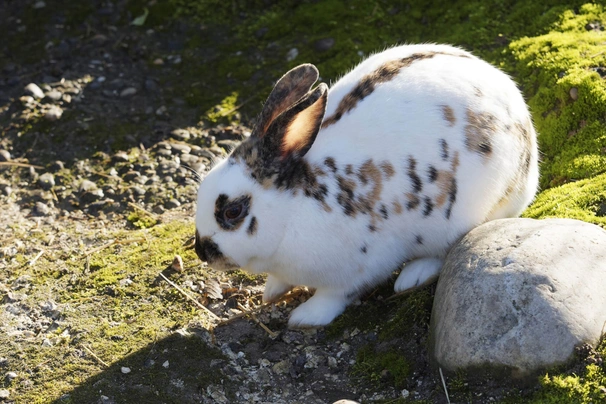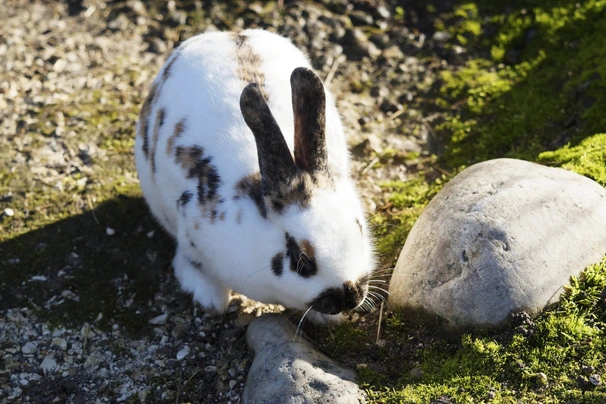Rhinelander
Introduction of the Rhinelander
The Rhinelander was initially developed in Germany and is instantly recognisable thanks to the striking butterfly markings on its face which are usually orange or black. The Rhinelander is predominantly white, with the black or orange markings.
The breed was founded in Germany in the early 20th Century and was exported to other countries in the 1920s. Although the Rhinelander was popular in Germany when it was first developed, interest in the breed waned following the Second World War. Even in the US, where fanciers display an enormous enthusiasm for their breeds, the Rhinelander experienced a decline in popularity and disappeared from view for forty years.
Today the Rhinelander is still rare – particularly in the US, where there are only around 2000 animals. In the UK it is also recognised as a rare breed.
History of the Rhinelander
The first recorded appearances by Rhinelanders at shows in its native Germany were in 1902. They were first developed in North Rhine-Westphalia from a doe of unknown breed and a grey Harlequin buck. Just one animal from that litter had the distinctive markings that Rhinelanders are renowned for, however a second mating – between a Harlequin buck and a Checkered doe produced a doe with similar markings and these two spotted kits were put together. The does from this litter were put to Harlequin bucks and the Rhinelander was the result.
By 1905 a breed standard had been devised and the breed was christened the ‘Rheinishe Schecke’. By 1924 the Rhinelander began to be exported to England and Holland and although it was very popular at first, interest soon decreased, as did the number of people trying to breed the animals. It proved difficult to selectively breed for the exact markings described by the breed standard, and the fact that the breed is slender and athletic, rather than cobby with plenty of meat, meant it was no good as a food source.
The breed experienced a resurgence in popularity in its native Germany after World War II and by 1978 the Rhinelander was the most popular spotted rabbit the country.
The Rhinelander was never hugely popular in America due again to the difficulty in achieving the desired markings although, since new stock has been imported to try and increase the US gene pool, interest has started to grow in the Rhinelander once more.
Appearance of the Rhinelander
- Main colourways: orange and black markings on a white coat
- Average weight: 2.7-4.5kg
The Rhinelander is an ‘arched’ breed of rabbit. This means that when the animal sits or moves, daylight can be viewed underneath it. It’s also a cylindrical or ‘barrel’ shaped rabbit , meaning it’s the same width from the shoulders to the hips.
The British Rabbit council only recognise a white coat with orange and black spots on the face and back. The Rhinelander also displays a distinctive ‘butterfly’ marking over the nose and lower jaw. In the US, the American Rabbit Breeders Association also recognises a fawn and blue coloured pattern on a white base coat, as well as the black and yellow varieties.
Temperament of the Rhinelander
The Rhinelander Rabbit is renowned for being friendly, calm and affectionate. It makes a great pet and because of its medium size, it’s easy to handle, without being too delicate. The Rhinelander is intelligent and curious and as such, can be trained to use a litter tray (useful if he’s going to live indoors!) and to come when called. His natural inquisitiveness also means he will generally get on well with other pets such as dogs, cats and guinea pigs, having said that, it’s important not to house your rabbit with a guinea pig as the larger bun can injure the smaller pig. They are social animals and will benefit from having a friend. Give him a rabbit pal instead and he’ll be in seventh heaven. Two neutered males or a neutered male and a female are the best combinations.
Make sure you know how to hold and carry a rabbit correctly before you bring him home. Rabbits that are picked up incorrectly can panic and become aggressive – they’re stronger than they look and can easily cause injury to themselves or their handler.
Health of the Rhinelander
Like all rabbits, Rhinelanders have quite delicate constitutions and can be susceptible to viruses and colds. Please make sure your pet is not subject to extreme fluctuations in temperature and is housed in a weather and waterproof environment. Stress can also affect his immunity, so make sure he has plenty of opportunities to exercise out of his hutch and also to totally relax in a safe space that’s away from prying eyes and noses!
Rhinelanders, like other breeds, can also suffer with conjunctivitis if they’re exposed to large amounts of dust, smoke and fumes. They can also suffer with ear mites; coccidiosis (parasites in the gut caused by being housed in unsanitary conditions), hairballs and bloat.
All rabbits should be treated for fleas, ticks and worms and must be vaccinated against myxomatosis and Viral Haemorrhagic Disease. Animals should be monitored for flystrike and must never be allowed to gain weight excessively so he can keep himself clean.
A rabbit’s teeth should be monitored closely as they grow continually and can get too long if they’re not worn down with diet and through the use of gnaw toys. Overgrown molars and enamel spurs can cause injuries in the mouth and problems with eating, so dental issues are best avoided.
Caring for the Rhinelander
A Rhinelander is the perfect house rabbit and will thrive indoors as long as he is allowed to roam and exercise regularly. Frequent access to fresh air and sunlight is also essential. This can be facilitated by a large run, a hutch extension or a large, secure area of garden. He can be taught to use a litter tray and should also be provided with a cage or crate where he can go to build his nest and completely relax. If you provide him with cardboard tubes and boxes to explore he’ll be happy, and gnaw toys and a few cat toys will also keep him entertained.
If he must be kept in a hutch, it should be big enough for him to hop around and stand on his hind legs. It should be completely weatherproof and located in a sheltered area. If you have an airy, well-lit shed this would be ideal. Any hutch must have a solid floor, as mesh floors can cause sore hocks, and it should be lined with shavings and straw. The hutch must be cleaned out weekly, with droppings and toilet areas removed and replaced daily.
He should be fed high quality pellets and hay, as well as lots of fibrous green vegetables that will keep his teeth worn down and his gut healthy, and he must have access to clean, fresh water at all times.


